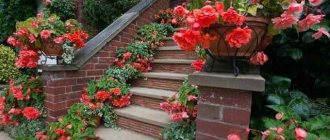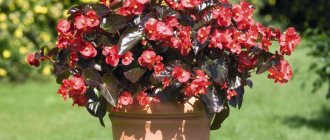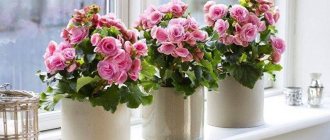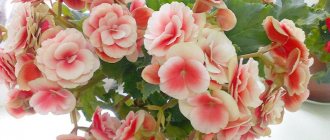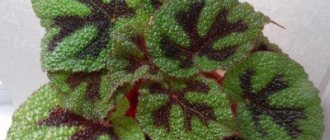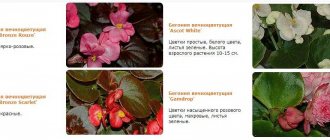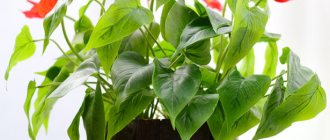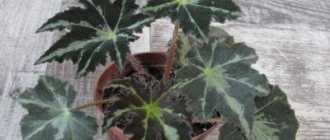How to care for coral begonia at home?
The flowerpot must have holes to remove excess moisture. A layer of drainage (broken brick, gravel, polystyrene foam) 2 cm high is poured into the container, then the pot is filled with soil compost. The flower is illuminated by diffused sunlight.
It is necessary to water the plant after 2 cm of soil substrate has dried. Coral begonia is sensitive to drafts, so it is better to place it where there is no air flow and the temperature is 17-24˚C.
To plant plants, purchase a clay pot, on the bottom of which a drainage layer of pebbles or expanded clay is placed. Then they fill it with soil substrate, make a shallow hole and place the seedling in it. The soil is watered abundantly.
Young plants must be replanted annually (in spring or early summer). The new pot should be 2 cm larger than the previous one. Older bushes need to be replanted less frequently (use the method of transshipment or replacement of the top layer of substrate).
A sharp knife is used to trim the plant. This procedure is carried out when the stem grows to 10 cm. To stimulate the formation of lateral shoots, it is recommended to cut the stems after 3-4 internodes. The brushes that have dried out after flowering are cut off so that the coral begonia does not lose nutrients and strength. The plant can be shaped into a pyramid or ball if desired.
If you do not engage in the formation of a bush, then it is necessary to carry out anti-aging pruning annually. In early spring, all stems are trimmed to 7 cm in height. After this procedure, the process of active formation of new shoots begins.
The temperature regime after pruning cannot be changed, since coral begonia can be attacked by pathogenic microorganisms.
In winter, the amount of watering is reduced and the temperature is lowered to 15-16˚C. Periodically (in the morning or evening) the flowerpot with the plant should be placed under the sun's rays to prevent the leaves from fading.
How and under what conditions does it bloom?
Begonia flower - propagation at home
If the plant is not sick, it will bloom in the spring. The flower stalks not only look beautiful, but also emit a pleasant aroma.
Coral begonia is an unpretentious plant; if you choose the right place for growing, ensure optimal air temperature and apply fertilizer on time, then inflorescences can appear all year round.
Why may begonia not bloom? Often the cause is a lack of nutrients.
Diseases and pests: treatment methods
If the bush is in a room with an inappropriate temperature or the soil is excessively moist, coral begonia may develop gray rot or powdery mildew. In this case, gray or brown spots appear on the leaf blades. Damaged leaves are cut off and the plant is treated with Bordeaux mixture or fungicide solution. Bacterial spotting may also appear on the leaf blades in the form of small watery specks. The bush must be destroyed and the pot disinfected. For preventive purposes, the plant can be treated in advance with a 0.5% solution of copper oxychloride.
If coral begonia is in a room with dry air, it may be attacked by spider mites or aphids. To get rid of pests, the bush is treated with tobacco infusion or insecticide solution.
1.Seven secrets of success:
| 1. Growing temperature : throughout the year the ideal temperature range is between 18 to 24°C, during the winter months the room temperature should not fall below 13°C. |
| 2. Lighting : shading from direct rays of the sun during hot daytime hours in spring and summer. |
| 3. Watering and air humidity : dry the soil 1.5 cm deep between waterings, increase air humidity using a room humidifier or a tray with wet pebbles. |
| 4. Pruning : Trim old yellowed leaves and remove faded flowers. |
| 5. Soil : nutritious, well-drained substrate. |
| 6. Feeding : every week with mineral fertilizers in half concentration, in winter you can feed monthly. |
| 7. Reproduction : leaf and apical cuttings, rooted in spring and summer. |
Botanical name: Begonia x corallina.
Family . Begoniaceae.
Homeland of the plant . South America.
Coral begonia description. These plants look great all year round. Even in the absence of flowering, elegant leaves and cascading stems will attract attention. The leaves are large, glossy, green, often spotted with white, large speckles and a reddish underside. The flowers simply add extra spectacle to this begonia. The flowering time for each variety varies, but most of these plants bloom in the spring. Flower colors vary from soft pink to dark red. These are some of the most spectacular plants in the world and one of the easiest begonias to cultivate.
Height . Up to 90 cm in height.
How to propagate coral begonia?
The plant can be propagated by the following methods:
- cuttings. Break off a healthy cutting up to 10 cm long, place it in water or wet sand (in this case, cover it with a glass jar). After some time, roots appear, the seedling can be transplanted into the soil substrate;
- leaves. A large leaf blade is cut off, cut into pieces in places where large veins branch, placed in moistened soil and covered with plastic film;
- dividing the rhizome. The procedure is carried out during transplantation. This method helps rejuvenate the plant.
Morphological characteristics of begonia
Morphological characteristics of begonia:
The begonia flower is native to the tropics and subtropics of South America, Asia and Africa.
The benefits of pumpkin for the body: benefits, harm, medicinal properties and cooking features (120 photos)
Begonias that are grown at home are conventionally divided into 4 groups:
flowering (begonia ever-flowering, its hybrids Elatior and Lorriane); tuberous (tuberous begonia); decorative deciduous (royal begonia, b. tiger paws); bush (begonia fuchsia, B. palmate petal).
Blooming begonias are often covered with numerous large double flowers in different colors: red, pink, yellow or white.
Planting tuberous begonia Tuberous begonia species are low plants with green or white-pink stems, large leaves, large single simple, semi-double and double flowers. Plants of this group bloom almost all summer and autumn.
Decorative deciduous - have a creeping rhizome and very beautiful decorative leaves with a silver or brown stripe along the edge.
Bush begonias are characterized by a long, erect stem on which lateral shoots develop; their leaves are small or large, have different shapes and are brightly colored. Flowers are located on high peduncles and collected in brushes.
planting tuberous begonia, begonia care at home photo, how to propagate begonia
Use in landscape design
Coral begonia, pelargonium and balsam complement each other in the interior of the room. They can easily be used to create an interesting composition in which each flower looks very impressive. Pots can be placed horizontally in a common stand or an elongated box, as well as vertically on divider shelves, high stands equipped with rings or shelves at different levels. In the room, the plant can be placed in a free corner to soften the vertical.
If you follow simple rules for caring for this Brazilian beauty, she will give you beautiful flowers and create a festive atmosphere and favorable microclimate in your apartment.
Reproduction (reproduction methods)
- This representative of the plant world can reproduce:
- seeds
- cuttings
- dividing the bush
The most common method of propagating coral begonia is cuttings. To use it, in the spring and summer, it is necessary to cut off the non-flowering stems from the plant with a knife, the length of which must be at least ten centimeters, under the bottom leaf. The lower leaves need to be torn off, and the cuttings placed in small containers, pre-filled with a mixture of wet peat and coarse sand, taken in equal parts.
Water the cuttings and then cover them with plastic wrap, securing it to the pots with an elastic band. Before roots appear, the cuttings should be placed in a room where the air temperature is eighteen degrees Celsius.
What are the harms and benefits of palm oil, and what products contain it?
Plant lifespan
On average, a guest from the tropics lives about four to five years, but if you propagate it using stem cuttings, it can live much longer.
Landing
“Coralline” belongs to the most common group of plants - moderate lighting, so it fits perfectly with other similar representatives of the flora. Remember that placing flowering plants in close proximity to each other risks cross-pollination and changes in flowering
Still, it is important to carry out the planting procedure correctly. Experts recommend adhering to the following algorithm:
- prepare a container of the appropriate size with a hole in the bottom, this will allow excess moisture to freely leave the pot, not stagnate and not have a detrimental effect on the root system;
- at a level of approximately 2 centimeters, create a drainage layer, for which the following are suitable: broken brick, pebbles, polystyrene foam, expanded clay or gravel;
- the drainage layer should be wider than the bottom;
- clay pots are preferred, since its composition is safe, and it does not heat up as quickly as other materials;
- for moisture-permeable soil, it is recommended to purchase a ready-made mixture for violets or combine the necessary components yourself;
- optimal soil composition: two parts ordinary soil, part compost, part peat, part sand;
- The following combination is also possible: two parts of sheet soil, two parts of humus and part of sand;
- The optimal time for planting is spring; after purchasing a flower, you should not replant it immediately; you need to give it time to adapt to new conditions within a week or two.
The main condition for healthy development and beautiful flowering of begonias is proper care. Although it is not complicated, it has certain features that need to be remembered. It is recommended to care for “Coralline” at home as follows:
- avoid direct sunlight, as begonia can burn its leaves in direct sunlight, so you should not place it on a south-facing window or balcony;
- provide access to natural diffused lighting; slight shading does not harm the development of the flower;
- in winter the plant feels great on the windowsill in the absence of drafts;
- It is best to place the flower on the window from the west, east or north;
- do not open the windows or remove the begonia from the window when ventilating, do not place it next to radiators and heaters;
- draft, cold and lack of light will either slow down the development of the flower or lead to its disease and death.
Moisturizing "Coralline" has a number of features:
- summer watering should be very abundant and regular;
- drying out threatens disease and death of the plant;
- water with potassium fertilizer once every 2 weeks;
- in spring, the plant is supported with phosphates;
- Watering in winter should be reduced to moderate.
Remember that optimal temperature and humidity will have a beneficial effect on the development of begonia. Therefore, it is recommended to carry out moisturizing air treatments around the flower on a regular basis.
In this case, you cannot spray the leaves. The temperature should ideally fluctuate between +15 +16 degrees in winter and +18 +24 degrees in summer. As a care procedure, it is necessary to cleanse the bush of dead leaves and inflorescences, otherwise they draw out useful microelements and prevent the formation of a new inflorescence.
Pruning and pinching are necessary conditions for the formation of a beautiful, well-groomed plant. It is recommended to pinch the crown so that the plant bushes, developing very impressive leaves on the sides. Excessively elongated stems must be trimmed regularly, otherwise the plant will lose its neat appearance.
Florist experts advise pruning those shoots that appear behind the third internode. They can be used for seedlings.
Description of indoor plant
Coral begonia is an ornamental foliage plant belonging to the large family Begoniaceae. The coral variety of this flower came to us from Brazil. When grown at home, the stem of coral begonia can reach a height of 60 cm to 1 m, and in the wild - up to 1.5 m.
| Root system | fibrous |
| Stem | Erect |
| Leaf Shape | Oval, cut or elongated |
| Leaf color | Shades of green with spots of white and silver |
| Flower shape | Umbrella inflorescences, clusters |
| Flower color | Coral, pink, light purple |
Possible problems
Problems when growing begonias:
- When growing this flower, you may notice that it drops its leaves. If in winter there is a massive fall of them, it means that the room is very cold and the plant is freezing. Raising the temperature will help.
- If the leaves become colorless before they fall off, then the coral begonia is infected with a nematode. Treatment is useless; the plant and contaminated soil must be disposed of.
- When a flower is in the kitchen, the leaves can often wilt. The cause of this problem is the harmful gas combustion products, so it must be moved to another room.
We invite you to watch a video about possible problems when growing coral begonia:

